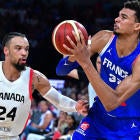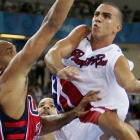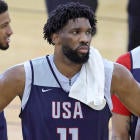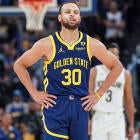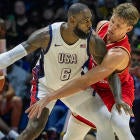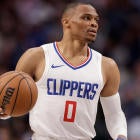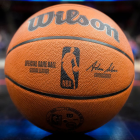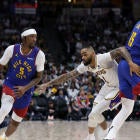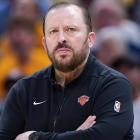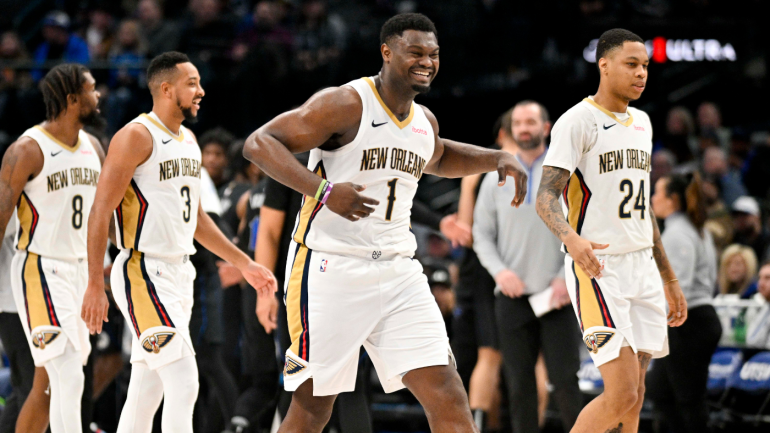
At practice after the All-Star break, New Orleans Pelicans coach Willie Green put Zion Williamson and Brandon Ingram on opposite teams. The games were more competitive than normal. They were louder than normal, largely because of all the talking that Williamson and Ingram were doing.
Over the break, Ingram said, the Pelicans got the "refresher" that they needed, and they came back with a new "sense of urgency." After two years in the Play-In Tournament, they wanted to avoid it this time.
With urgency came "more attention to detail" and "more focus on the game plan," Ingram said. Players held each other accountable. They "got in a rhythm of how we're going to play," and they worked on what they were supposed to work on. At game time, they were more prepared.
"Willie's been doing a good job," Ingram said. "Some days where we don't necessarily want to practice, we're in there practicing. Just for us to be prepared for the next game. A lot of teams don't really, really practice in March. I think our approach is different. We're learning more."
Ingram said this three weeks ago at his locker in Barclays Center with his feet in an ice bucket, following a 104-91 win against the Nets. At that time, New Orleans was fifth in the West, a half-game behind the fourth-place Clippers, and riding high, having won seven of its last eight games. After the buzzer in Brooklyn, big man Larry Nance Jr. had declared in a walk-off interview that the Pelicans were "really scary" and "going to be a problem for somebody."
New Orleans was 83% through the regular season, and, unlike the past few years, its stars were healthy. It appeared to be peaking at the perfect time.
"I think that's what it takes, every team needs a little bit of luck," Ingram said. "The injury bug hasn't been around."
Two days later, in Orlando, Ingram hyperextended his left knee. A week after that, against Oklahoma City, Jose Alvarado, the Pelicans' sparkplug, took hits on consecutive possessions and strained his right oblique. The following week, in a rematch against the Magic, Williamson hurt his finger blocking a shot. Ingram has now missed 10 straight games, and New Orleans went 1-4 without Alvarado, including a heartbreaker against San Antonio without Williamson. The Pelicans are 47-32 and sixth in the West, fighting like hell to make the playoffs outright, with games against the Kings, Warriors and Lakers coming up and little time to reintegrate Ingram before the postseason. For a team that looked so good so recently, it's an awfully precarious position to be in.
It is not, however, an unfamiliar one. Since 2019, when Williamson, Ingram and executive vice president David Griffin arrived, every time New Orleans has looked like a team on the rise, injuries have stalled its ascent. If Griffin's former team, the Cleveland Cavaliers, were "drama kings" for whom making history was simply part of their identity, as he described them in an email to the entire company when they were down 3-1 in the 2016 NBA Finals, then the Pelicans are the sultans of snags. If their story had stayed as straightforward as it seemed back in Brooklyn, if there hadn't been some sort of late-season twist, it wouldn't be them.
Broadly speaking, this is a team that has galvanized itself after setbacks. In 2021-22, New Orleans went on a late-season run without Williamson, survived the play-in and gave the No. 1-seeded Phoenix Suns a fright. Last season, with Williamson, Ingram and CJ McCollum sharing the court only 10 times, several players got to play elevated roles for an above-.500 team. "We got a lot of confidence," Alvarado said. "Obviously having our superstars healthy and here with us is a big part of that, too, but we also improved and worked on our game when they wasn't."
If the Pelicans' most recent string of bad luck is particularly painful, though, it's because, leading up to it, they were in new territory. They'd been a good team before, but "this is a better team," Ingram said, with "more weapons, people that can put the ball on the floor, people that can defend, people that can shoot." Should they fail to escape the play-in, the outcome will not reflect the way the group had come together. Should they recapture the mojo they had a month ago, watch out.
Before the season started, McCollum sat down with Green, associate head coach James Borrego and assistant coach Casey Hill. The four of them discussed how, in his 11th year in the NBA, one of the league's premier bucket-getters could help his team by being less of a bucket-getter.
"Obviously, I like to play iso, I like pick-and-roll," McCollum said. "I'm one of the best midrange shooters in the last decade, based on numbers and percentages. But that's not what we need every possession. We need somebody to space the floor."
New Orleans had hired Borrego, who was the coach of the Charlotte Hornets when they had the league's sixth-best offense in 2021-22 (according to Cleaning The Glass, which filters out garbage time), in part because it needed to revamp its attack. The Pelicans wanted a more modern shot profile, and they wanted to put the ball in Williamson's hands more often. This meant they needed McCollum to embrace a more off-ball role, particularly when he's on the court with both Williamson and Ingram.
And he has. McCollum is not only shooting 41.7% on 9.2 3-point attempts per 36 minutes (up from 7.4 per 36 last season), he's taking catch-and-shoot 3s far more frequently (5.3 per 36 minutes) than at any other point in his career. Overall, 57% of his made shots have been assisted (up from 47% last season and 39% the previous one), and long 2s account for just 10% of his shot diet (a huge drop, as this number ranged from 18% to 29% in each of his first 10 seasons), per CTG.
"Sometimes I need to be an orchestrator, sometimes I need to be in the corner, sometimes I'm in scoring mode, but I just do whatever it takes for us to win," McCollum said. "For us to win, somebody in the starting lineup has to shoot 3s, right? Everybody can't play in the midrange."
McCollum has worked on "being cognizant of actions that get me 3-pointers" and "understanding the flow of the offense," he said. Nance said that McCollum's willingness to adapt "speaks volumes" about his professionalism.
"Our guys are BI and Z," Nance said. "They are who's going to take us to where we need to be. And CJ has done an awesome job of changing his game, tuning his game to their frequency."
The Pelicans' coaching staff entered the season wanting to inject more energy into the offense, both in terms of how quickly they took advantage of transition opportunities and how much player movement they had in the halfcourt. They wanted fewer isolations, more trust and, crucially, better spacing, which tends to lead to better decision-making. They knew they could put pressure on the rim, and they wanted to create open 3s, particularly in the corners, where they ranked bottom-five in shot frequency last season, per CTG.
All season, Borrego has preached pace, aggressiveness and "playing for others," Ingram said. "Just trying to get the best shot on the floor every single time that we come down. Having ball movement with that. We got a lot of great players, but the great players can't be used if it's stagnant on the floor. So he's implemented that."
Some of this is "a simple math equation," New Orleans forward Trey Murphy III said. "If you get up more 3s and you make more 3s, you're going to win the game. So that's really all it boils down to. We struggled to get up 30 3s last year. Every game, we shoot for 40 3s now."
Before Ingram's injury, the Pelicans had the NBA's ninth-best offense, up from 20th last season. The most obvious factors were Williamson being available and Herb Jones turning into a threat, but there was more to it. They'd made 42.6% of their corner 3s, the second-best mark in the league, and they'd taken them an above-average rate, per CTG.
The offense has since dipped a bit without Ingram, and McCollum has had to get back in his bag -- he's averaging 26.7 points and 5.6 assists in 38.5 minutes with a 29.2% usage rate in the last 10 games -- but their turnover rate has continued to improve: they're 13th now, up from 22nd last season. And while they are still not averaging 40 3-point attempts, this past Sunday In Phoenix, in their most important win of the season, they shot 16 for 39.
"Honestly it feels like things have been coming together, slowly, since the start of the year," Nance said. "I feel like every month of the season, we just got 10% better, 10% better, 10% more comfortable."
At their best and most entertaining, the Pelicans are a blur of forced turnovers and fast breaks. Per possession, New Orleans ranks second in steals, and many of them immediately turn into highlights. When reserve wing Naji Marshall picked Nets guard Cam Thomas' pocket and connected with Williamson on an outrageous alley-oop, the ball was in the air with 22 seconds on the shot clock.
To see the Pelicans at their most electric, watch their second unit. When Alvarado and Marshall walk on the court, the game changes. "We pick up the intensity," Marshall said. "That's kind of our job." Their mindset is to "win our minutes," Alvarado said. "We want to outwork everybody out there that's in front of us." On the season, New Orleans has had the third-best bench in the league by aggregate net rating, but that might be underselling it. The Pelicans have outscored opponents by 11.5 points per 100 possessions in Alvarado's minutes, 8.6 per 100 in Marshall's and 7.2 per 100 in Murphy's.
"I have 100% trust in everybody that's coming off that bench because I've seen it over and over again," Ingram said. "I see how they work, I've seen the character, I know the mindset of everybody. We got guys coming off the bench that's hungry."
One particular lineup, featuring Williamson and four reserves -- Alvarado, Marshall, Murphy and Nance -- has outscored opponents by a mind-boggling 29.4 points per 100 possessions.
"Obviously, Z is the North Star of that group, of course, and so for us it's all about how do we fit in, how do we fit our puzzle pieces around him," Nance said.
Nance likened Murphy, an overqualified sixth man, to Denver's Michael Porter Jr. because "he's 6-9, 6-10 and can space from 32 feet." Sitting on the sideline at shootaround in Brooklyn, Nance emphasized that he was not exaggerating, and the team didn't just allow for an occasional deep one. "It's like, no, that's where we want him spaced -- at that S or Y in BARCLAYS," he said, pointing at the logo beyond the 3-point line. The Pelicans like to get Murphy on the move, too, and they often use him as a screener (or ghost screener) for Williamson. These actions confused defenders when it was Terry Rozier darting out to the 3-point line and Miles Bridges handling the ball for Borrego's Hornets; with this personnel, they present more problems.
"His release point is high, he's a tall dude, so you gotta stay close to him. And with Derrick Henry in the middle, it's hard to defend that," Nance said.
As the nominal center next to Williamson, Nance often hangs in the dunker spot, but, "sometimes, if I see, hey, my man's helping out a lot, [Ivica] Zubac's helping out a lot, I step out to 3, where I'm shooting a good percentage," he said. The killer lineup works naturally because "the guys around [Williamson] are understanding how to play off his gravity," Green said, "and then on the other side, all of those guys on the floor being committed to guarding the ball, contesting shots, making sure that we rebound." The only problem is that they've only shared the floor for 78 total minutes. While the Pelicans had found some rhythm with their rotation weeks ago, all the injuries (and Dyson Daniels' return from injury) have complicated matters.
Even when shorthanded, New Orleans has flexibility. Jonas Valanciunas, its sturdy starting center, sometimes dominates on the interior, but almost never closes games. Last week he had a 27-7-7 stat line against Spurs, then played only four minutes against the Suns. At full strength, the Pelicans' crunch-time lineup typically comes from a pool of six players -- Williamson, Ingram, McCollum, Jones, Murphy and Nance -- but who sits varies.
In a difficult loss against the Celtics, they went centerless for the entire fourth quarter in order to maximize their spacing. In a memorable win against the Clippers, they took out McCollum for the final three and a half minutes in order to maximize their switchability. Now that Jones is knocking down 3s and showing off his passing ability, it's difficult to keep him off the court.
The rare defensive stopper who is equally proficient at locking opponents down one-on-one and flying around the court to wreak havoc, Jones will likely earn All-Defense honors. Nance said that "he better" get the nod, and that Jones might be his favorite player. Ever.
"He is about everything right in the game of basketball to me," Nance said. "Every single day, he's working on his craft, shooting at practice, shooting before practice, shooting after practice, working on his fast transition lays, which he's elite at. If I could point any young player in the league to watch [one player's] progression, watch their care, watch their caliber of work, it's Herb."
Four months ago, in the semifinals of the inaugural In-Season Tournament in Las Vegas, New Orleans was embarrassed. The team didn't just lose to the Lakers; it lost by 44 points, and Williamson looked listless and lethargic. On TNT's "Inside the NBA," Shaquille O'Neal said Williamson "doesn't run hard" and Charles Barkley said "he's gotta get in shape." Christian Clark of The Times-Picayune reported that the Pelicans had talked to Williamson multiple times about his diet and conditioning, but he "doesn't listen," citing multiple team sources.
It was not the first time that Williamson's weight was the subject of public discussion, but, until then, he had always put up huge numbers anyway. In Vegas, he scored 13 points and went 1 for 6 from the line.
Williamson responded, in the immediate sense, by scoring 36 points on 13-for-17 shooting in his next game, a double-digit win against Minnesota. The real response, though, was what happened consistently over the months that followed: Williamson got in the gym and demonstrated that he'd matured as a worker and competitor. He is now fitter than he's ever been.
This version of Williamson is making good on the defensive potential he showed at Duke. He makes multiple-effort plays, guards opposing stars and sustains his energy late in games, even when he's carrying the Pelicans offensively. Three of his five (!) blocks against the Suns came in the fourth quarter, including one supermassive swat against Kevin Durant.
"I think he's always had that," Jones said. "It was just a matter of doing it every game. And that comes with time. I don't think a lot of people come into the NBA realizing how long of a season it is, the ups and the downs. Like some days, life may happen, and you might not want to come in and give it 110% on the defensive end. But I think he's kind of understood the importance of just giving max effort each play and being OK with the result."
Ingram, too, has had his best defensive season. His best playmaking season, too.
"I haven't been a winner in the league, right?" Ingram said. "And this is the best team that I've been on. So I'm learning different things. I'm learning some nights to sacrifice, some nights are not going to be my night."
Ingram, who is still listed as out for Thursday's game in Sacramento, has worked individually with Borrego, and he said the two have had a "constant dialogue" about taking what the game is giving him. "He makes sure that he's in my ear every single day, just keeping me going, making sure I'm levelheaded," Ingram said. The coaching staff has asked Ingram to get to the rim, where he's shooting a career-high 72% (per CTG), to make the right reads when the defense collapses and to get off the ball quickly when he's blitzed. His scoring, shot attempts and usage are all the lowest they've been in New Orleans, but his game has never been more well-rounded.
Green said he wouldn't necessarily describe the Pelicans' three top playmakers as "comfortable" playing off each other yet, but they've made progress and deserve credit for buying in. Ideally, Ingram's shot profile would look a bit more like McCollum's, but his catch-and-shoot 3s have been about half as frequent.
New Orleans has a negative point differential with Williamson, Ingram and McCollum on the court (and is plus-7.9 per 100 possessions with exactly two of them, per pbpstats.com), but this doesn't reflect how hard they've tried to coalesce. Taken with the Pelicans' late-game issues, however -- they have a bottom-five offense in the clutch and are 5-11 in games decided by six points or fewer -- the numbers point to some real challenges: They don't have a floor general, they struggle in games of execution and they're still learning how to win.
Which is why, when Williamson took complete control of the game in Phoenix, it was so meaningful. Williamson scored 12 of his 29 points in the fourth and even made a midrange pull-up -- his second of the night -- with less than five minutes remaining. "That shit was legendary," Murphy said afterward, per The Athletic. Between the timely scoring, the defensive stops and the fact that he logged 40 minutes, it was a signature moment for a 23-year-old superstar who has clearly gotten serious. If the Pelicans can finish the regular season with the same force and poise, maybe they are indeed a scary team. Maybe they will be a problem for somebody.
"New Orleans never had a team like this," Ingram said.










